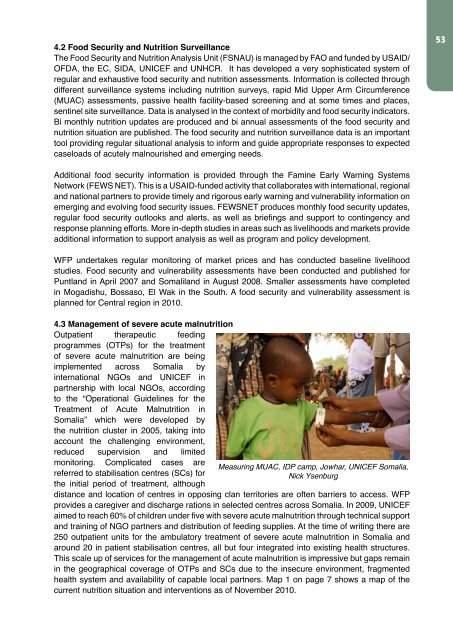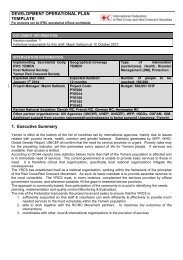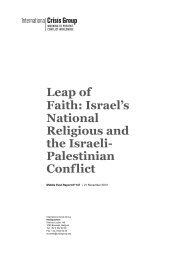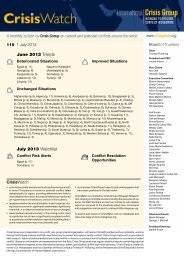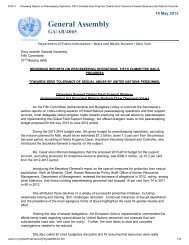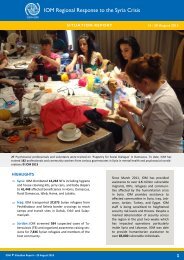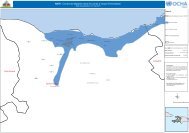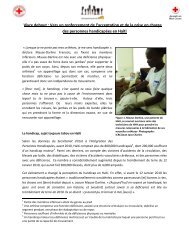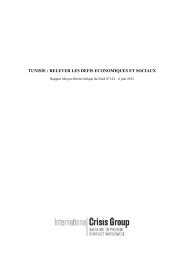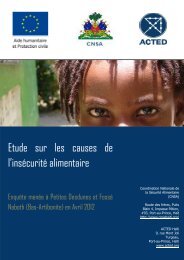SOMALI NUTRITION STRATEGY 2011 – 2013 - ReliefWeb
SOMALI NUTRITION STRATEGY 2011 – 2013 - ReliefWeb
SOMALI NUTRITION STRATEGY 2011 – 2013 - ReliefWeb
You also want an ePaper? Increase the reach of your titles
YUMPU automatically turns print PDFs into web optimized ePapers that Google loves.
4.2 Food Security and Nutrition Surveillance<br />
The Food Security and Nutrition Analysis Unit (FSNAU) is managed by FAO and funded by USAID/<br />
OFDA, the EC, SIDA, UNICEF and UNHCR. It has developed a very sophisticated system of<br />
regular and exhaustive food security and nutrition assessments. Information is collected through<br />
different surveillance systems including nutrition surveys, rapid Mid Upper Arm Circumference<br />
(MUAC) assessments, passive health facility-based screening and at some times and places,<br />
sentinel site surveillance. Data is analysed in the context of morbidity and food security indicators.<br />
Bi monthly nutrition updates are produced and bi annual assessments of the food security and<br />
nutrition situation are published. The food security and nutrition surveillance data is an important<br />
tool providing regular situational analysis to inform and guide appropriate responses to expected<br />
caseloads of acutely malnourished and emerging needs.<br />
53<br />
Additional food security information is provided through the Famine Early Warning Systems<br />
Network (FEWS NET). This is a USAID-funded activity that collaborates with international, regional<br />
and national partners to provide timely and rigorous early warning and vulnerability information on<br />
emerging and evolving food security issues. FEWSNET produces monthly food security updates,<br />
regular food security outlooks and alerts, as well as briefings and support to contingency and<br />
response planning efforts. More in-depth studies in areas such as livelihoods and markets provide<br />
additional information to support analysis as well as program and policy development.<br />
WFP undertakes regular monitoring of market prices and has conducted baseline livelihood<br />
studies. Food security and vulnerability assessments have been conducted and published for<br />
Puntland in April 2007 and Somaliland in August 2008. Smaller assessments have completed<br />
in Mogadishu, Bossaso, El Wak in the South. A food security and vulnerability assessment is<br />
planned for Central region in 2010.<br />
4.3 Management of severe acute malnutrition<br />
Outpatient therapeutic feeding<br />
programmes (OTPs) for the treatment<br />
of severe acute malnutrition are being<br />
implemented across Somalia by<br />
international NGOs and UNICEF in<br />
partnership with local NGOs, according<br />
to the “Operational Guidelines for the<br />
Treatment of Acute Malnutrition in<br />
Somalia” which were developed by<br />
the nutrition cluster in 2005, taking into<br />
account the challenging environment,<br />
reduced supervision and limited<br />
monitoring. Complicated cases are<br />
referred to stabilisation centres (SCs) for<br />
the initial period of treatment, although<br />
Measuring MUAC, IDP camp, Jowhar, UNICEF Somalia,<br />
Nick Ysenburg<br />
distance and location of centres in opposing clan territories are often barriers to access. WFP<br />
provides a caregiver and discharge rations in selected centres across Somalia. In 2009, UNICEF<br />
aimed to reach 60% of children under five with severe acute malnutrition through technical support<br />
and training of NGO partners and distribution of feeding supplies. At the time of writing there are<br />
250 outpatient units for the ambulatory treatment of severe acute malnutrition in Somalia and<br />
around 20 in patient stabilisation centres, all but four integrated into existing health structures.<br />
This scale up of services for the management of acute malnutrition is impressive but gaps remain<br />
in the geographical coverage of OTPs and SCs due to the insecure environment, fragmented<br />
health system and availability of capable local partners. Map 1 on page 7 shows a map of the<br />
current nutrition situation and interventions as of November 2010.


